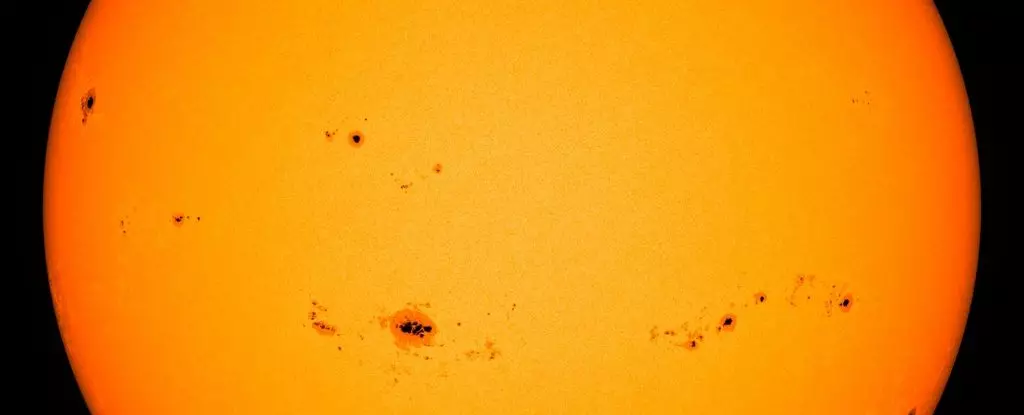Recent declarations from NASA, the NOAA, and the Solar Cycle Prediction Panel have confirmed the onset of solar maximum, marking a peak in the Sun’s 11-year activity cycle. This pivotal phase is characterized by an increase in sunspots, solar flares, and coronal mass ejections (CMEs). While it’s an exciting time for solar scientists and enthusiasts, it raises questions about the implications of these phenomena for life on Earth.
Solar maximum does not simply signify a surge in the Sun’s energy output; it heralds a period of increased solar behavior that can have far-reaching effects on our planet. Understanding the dynamics of this cycle is crucial, especially since the Sun shapes much of what we experience in our daily lives, from weather patterns to technological operations.
Solar cycles are driven by complex magnetic interactions within the Sun—a subject that remains only partially understood by scientists. Each cycle lasts about 11 years but can vary significantly in duration and intensity. As meteorologist Elsayed Talaat of NOAA points out, the actual peak of solar activity within solar maximum will not be known until well after this event has occurred. This uncertainty speaks to the nuanced complexities of solar dynamics, as there is much we still don’t understand about the Sun’s interior processes and magnetic fields.
Astrophysicist Michael Wheatland highlights the challenges associated with solar cycle prediction, emphasizing that our grasp of the solar dynamo responsible for generating magnetic fields and sunspots is still inadequate. This mystery is an ongoing challenge for astro-physicists and hinders our ability to predict when solar maximum will culminate.
Sunspots: The Markers of Solar Activity
Understanding sunspots is foundational when discussing solar cycles. These dark patches on the Sun’s surface indicate areas where magnetic activity inhibits the flow of hot plasma, resulting in cooler and darker regions. Sunspot counts serve as vital indicators of solar activity, with solar minimum corresponding to a scarcity of sunspots and solar maximum indicating an abundance.
During solar maximum, the Sun often erupts with solar flares—intense bursts of light and energy resulting from the rapid reconfiguration of tangled magnetic field lines. These phenomena can manifest in radio blackouts on Earth. Additionally, CMEs can hurl vast amounts of solar material into space, with the potential to disrupt electrical grids and communication systems when they collide with Earth’s magnetic field.
The interactions between solar activity and Earth’s magnetic field can lead to geomagnetic storms—events that can have both destructive and beautiful consequences. On one hand, these storms may create current surges that threaten power infrastructure, impede navigation systems, and jeopardize satellite operations. On the other hand, they can also give rise to breathtaking auroras, as charged solar particles collide with particles in Earth’s upper atmosphere.
This year has already witnessed numerous auroral displays, thanks to the surge in solar activity. The lure of these celestial light shows stands in stark contrast to the potential hazards posed by intense solar weather, underscoring the dual nature of solar phenomena.
The ongoing solar cycle is proving to be more vigorous than predicted, though it is not the most potent on record. The most significant flare documented thus far in this cycle—a powerful X9.0 flare—occurred on October 4, sitting comfortably within the top 20 flares ever recorded. Despite its strength, this cycle hasn’t reached the extremes seen in historical records.
Despite initial conservative predictions from institutions like NASA and the NOAA, some scientists had anticipated a stronger cycle with greater accuracy. This discrepancy could yield valuable insights into solar behavior and enhance our predictive models for future cycles, fostering a deeper understanding of stellar dynamics.
As we navigate this solar maximum, the complexity of the Sun remains an enigmatic frontier in astrophysics. While we may face stormy space weather ahead, the excitement of uncovering new knowledge about our star far outweighs potential risks. This period promises opportunities for exploration and emphasizes the importance of understanding solar dynamics. As researchers continue to analyze solar activity, we may find ourselves not only better prepared for the effects of solar weather but also privy to deeper mysteries about the universe and our place within it.
As we brace for the ongoing spectacle of solar activity, it’s essential to stay informed and appreciate the intricate relationship between the Sun and life on Earth. It’s a dynamic and captivating narrative that invites both caution and wonder, reminding us of the forces at play beyond our planet.

